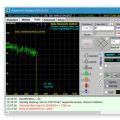Almost every novice radio amateur strives at the beginning of his creativity to design a power supply unit in order to subsequently use it to power various experimental devices. And of course, I would like this power supply to "prompt" about the danger of failure of individual units in case of installation errors or faults.
Today, there are many circuits, including those with an indication of a short circuit at the output. In most cases, a similar indicator is usually an incandescent lamp included in the load break. But with such an inclusion, we increase the input resistance of the power source or, more simply, we limit the current, which in most cases, of course, is acceptable, but not at all desirable.
The circuit shown in Fig. 1 not only signals a short circuit, absolutely not affecting the output resistance of the device, but also automatically disconnects the load when the output is short-circuited. In addition, the HL1 LED reminds that the device is plugged in, and the HL2 lights up when the fuse FU1 blows, indicating that it needs to be replaced.
Electrical schematic diagram of a homemade power supply with protection against short circuits
Consider the work of a homemade power supply... The alternating voltage taken from the secondary winding of T1 is rectified by diodes VD1 ... VD4, assembled in a bridge circuit. Capacitors C1 and C2 prevent the penetration of high-frequency noise into the network, and the oxide capacitor C3 smoothes the ripple of the voltage supplied to the input of the compensation stabilizer, assembled at VD6, VT2, VT3 and providing a stable voltage of 9 V at the output.
The stabilization voltage can be changed by selecting a Zener diode VD6, for example, at KS156A it will be 5 V, at D814A - 6 V, at DV14B - V V, with DV14G -10 V, with DV14D -12 V. If desired, the output voltage can be made adjustable, for this, between the anode and cathode of VD6, a 3-5 kΩ variable resistor is turned on, and the VT2 base is connected to the engine of this resistor.
Consider the operation of the protective device of the power supply... The short-circuit protection unit in the load consists of germanium pnp transistor VT1, electromagnetic relay K1, resistor R3 and diode VD5. The latter in this case performs the function of a stabilizer that maintains a constant voltage of about 0.6 - 0.7 V relative to the total on the basis of VT1.
V normal mode the operation of the stabilizer, the transistor of the protection unit is reliably closed, since the voltage at its base relative to the emitter is negative. When a short circuit occurs, the emitter VT1, like the emitter of the regulating VT3, turns out to be connected to the common negative wire of the rectifier.
In other words, the voltage at its base relative to the emitter becomes positive, as a result of which VT1 opens, K1 is triggered and disconnects the load with its contacts, the HL3 LED is on. After eliminating the short circuit, the bias voltage at the emitter junction VT1 again becomes negative and it closes, relay K1 is de-energized, connecting the load to the output of the stabilizer.
Details for the manufacture of the power supply. Any electromagnetic relay with the lowest possible operating voltage. In any case, one indispensable condition must be observed: the secondary winding of T1 must produce a voltage equal to the sum of the stabilization voltages and the operation of the relay, i.e. if the stabilization voltage, as in this case, is 9 V, and U is activated by the relay 6 V, then the secondary winding must be at least 15 V, but also not exceed the allowable one on the collector-emitter of the used transistor. As T1 on the prototype, the author used TVK-110L2. The printed circuit board of the device is shown in Fig. 2.
Power supply PCB
Every radio amateur who regularly designs electronic devices I think there is a regulated power supply at home. The thing is really convenient and useful, without which, having tried it in action, it becomes difficult to do without. Indeed, whether we need to check, for example, an LED, then we will need to accurately set its operating voltage, since if the voltage supplied to the LED is significantly exceeded, the latter can simply burn out. Also with digital circuits, we set the output voltage on the multimeter to 5 volts, or whatever we need and go ahead.
Many novice radio amateurs first assemble a simple adjustable power supply, without adjusting the output current and short circuit protection. So it was with me, about 5 years ago I assembled a simple power supply unit with only adjustment of the output voltage from 0.6 to 11 volts. Its diagram is shown in the figure below:

But a few months ago I decided to upgrade this power supply and supplement its circuit with a small short circuit protection circuit. I found this scheme in one of the issues of the magazine Radio. On closer examination, it turned out that the scheme is in many ways similar to the above. schematic diagram, assembled by me earlier power supply. In the event of a short circuit in the powered circuit, the short circuit indication LED goes out, signaling this, and the output current becomes 30 milliamperes. It was decided to take part of this scheme to supplement his own, which he did. The original, a diagram from the magazine Radio, which includes the addition, is given in the figure below:

The following figure shows the portion of this circuit that will need to be assembled.

The value of some parts, in particular the resistors R1 and R2, must be recalculated upward. If anyone still has questions about where to connect the outgoing wires from this circuit, I will give the following figure:

I will also add that in the assembled circuit, regardless of whether it will be the first circuit, or the circuit from the Radio magazine must be put at the output, between the plus and minus a 1 kOhm resistor. In the diagram from the Radio magazine, this is the resistor R6. Then it remains to etch the board and put everything together in the power supply case. Mirror boards in the program Sprint Layout no need. Drawing printed circuit board short circuit protection:

About a month ago, I came across a circuit for an output current regulator attachment that could be used in conjunction with this power supply. I took the scheme from this site. Then I assembled this set-top box in a separate case and decided to connect it as needed to charge batteries and similar actions, where control of the output current is important. I am giving the set-top box diagram, the kt3107 transistor in it was replaced with kt361.

But later the idea came to mind to combine, for convenience, all this in one body. I opened the power supply case and looked, there was not enough space left, the variable resistor would not fit. In the current regulator circuit, a powerful variable resistor is used, which has a rather large size. This is what it looks like:

Then I decided to simply connect both cases with screws, making a connection between the boards with wires. I also put the toggle switch in two positions: an output with an adjustable current and an unregulated one. In the first case, the output from the main board of the power supply was connected to the input of the current regulator, and the output of the current regulator went to the clamps on the power supply case, and in the second case, the clamps were connected directly to the output from the main board of the power supply. All this was commutated by a six-contact toggle switch for 2 positions. Here is a drawing of the circuit board of the current regulator:

In the picture of the printed circuit board, R3.1 and R3.3 indicate the terminals of the variable resistor first and third, counting from the left. If someone wants to repeat, I give a toggle switch connection diagram for switching:

The printed circuit boards of the power supply, protection circuits and current regulation circuits are attached in the archive. Prepared by AKV.
Short circuits occur in any electrical installation, regardless of their complexity. Even if the electrical wiring is new, the lamps and sockets are in good order, and the electrical equipment is produced by world-famous manufacturers, no one is insured against short circuits. And you need to protect yourself from them.
Devices for protection against emergency modes in the network
Fuses are the most simple devices protection. Previously, only them were used to eliminate emergency modes in household electrical wiring. Some devices still use fuses. The reason is that they have high performance and are indispensable for protecting semiconductor devices.
After blowing, the fuse is either replaced with a new one, or the fuse is replaced inside it. Inserts for the same fuse body are available for different current ratings. But the need to keep a supply of fuses for quick replacement at the facility or in the apartment is a disadvantage of fuses.
The most common fuse in Soviet times was the "plug".
Fuse - "plug"They were replaced by automatic plugs of the type STEAM, produced for currents of 10, 16 and 25 A. They were screwed into place of plugs, were reusable and had two protective elements called trip units. One protected from short circuits and worked instantly, the second - from overloads and worked with a time delay.

The same releases are available for all circuit breakers that replaced the fuses. Instantaneous release is called electromagnetic, because its operation is based on the principle of retraction of the coil stem when the rated current is exceeded. The rod hits the latch and the spring opens the circuit breaker contact system.
A time-delayed release is called a thermal release. It works on the principle of a thermostat in an iron or electric heater. When a current passes through it, a bimetallic plate heats up and slowly bends to the side. How more current through it, the faster the bend occurs. Then it acts on the same latch, and the machine turns off. If the action of the current has ceased, the plate cools down, returns to its original position, and no shutdown occurs.
In the old electrical switchboards, the automatic switches in the carbolite case of the types A-63, A3161, or more modern AE1030 are still preserved. But all of them no longer meet modern requirements.



They are worn out, and their mechanical part is either rusted or has lost speed. And not all of them have instantaneous short circuit protection. In some devices, only a thermal release was installed. And the speed of operation of the electromagnetic release for the automatic machines of these series is lower than that of the modular ones.
Therefore, such protective devices must be replaced with modern ones, until they have done things by their inaction.
Defense building principles
In apartment buildings, automatic machines are installed in a dashboard on the landing. This is enough to protect the apartments. But if you installed a personal dashboard when replacing the electrical wiring, then it is better to install a personal machine in it for each group of consumers. There are several reasons for this.
- When replacing the outlet, you do not need to turn off the lights in the apartment and use a flashlight.
- To protect some consumers, you will reduce the rated current of the machine, which will make their protection more sensitive.
- In case of damage to the electrical wiring, you can quickly turn off the emergency section and leave the rest in operation.
In private houses, two-pole switches are used as input switches. This is necessary in case of erroneous switching at a substation or line, as a result of which the phase will be at the zero point. The use of two single-pole switches for this purpose is unacceptable, since the one that is at zero may turn off, and the phase remains.

It is impractical to use a three-pole switch as the equivalent of three single-pole ones. Removing the bar connecting the three poles will not help. There are rods inside the circuit breaker that disconnect the remaining poles when one of them is triggered.
When using an RCD, it is imperative to protect the same line with a circuit breaker. RCD protects against leakage currents, but does not protect against short circuits and overloads. The functions of protection against leakage and emergency modes of operation are combined in differential automaton.

Selection of circuit breakers
When replacing an old circuit breaker, set the new one to the same rated current. According to the requirements of Energosbyt, the rated current of the circuit breaker is taken based on the maximum permitted load.
The distribution network is designed in such a way that the rated currents of the protection devices increase as the power supply is approached. If your apartment is switched on through a 16 A single-phase circuit breaker, then all apartments in the entrance can be connected to a 40 A three-phase circuit breaker and are evenly distributed in phases. If your machine does not turn off during a short circuit, after a while the overload protection will work at the driveway. Each subsequent protective device backs up the previous one. Therefore, do not overestimate the rated current of the circuit breaker. It may not work (there will not be enough current) or it will turn off together with a group of consumers.
Modern modular circuit breakers are available with characteristics "B", "C" and "D"... They differ in the multiplicity of cutoff actuation currents.
Be careful when using machines with characteristics "D" and "B".
And remember: if the short circuit is not disconnected, it will cause a fire. Take care of the health of the protection, and live in peace.
The devices need a power supply unit (PSU), which has an output voltage adjustment and the ability to regulate the level of operation of protection against overcurrent over a wide range. When the protection is triggered, the load (connected device) must be automatically disconnected.
A search on the internet yielded several suitable power supply circuits. Stopped at one of them. The circuit is easy to manufacture and set up, consists of available parts, and fulfills the stated requirements.
The proposed power supply is based on the LM358 operational amplifier and has the following characteristics:
Input voltage, V - 24 ... 29
Output stabilized voltage, V - 1 ... 20 (27)
Protection operation current, A - 0.03 ... 2.0
Photo 2. Power supply circuit
Description of BP operation
The regulated voltage regulator is assembled on the DA1.1 operational amplifier. An exemplary voltage is supplied to the amplifier input (pin 3) from the engine of the variable resistor R2, for the stability of which the Zener diode VD1 is responsible, and to the inverting input (pin 2) the voltage is supplied from the emitter of the transistor VT1 through the voltage divider R10R7. Using a variable resistor R2, you can change the output voltage of the PSU.
The overcurrent protection unit is based on an operational amplifier DA1.2, it compares the voltages at the inputs of the op-amp. Input 5 through resistor R14 receives voltage from the load current sensor - resistor R13. An exemplary voltage is supplied to the inverting input (pin 6), for the stability of which the diode VD2 is responsible with a stabilization voltage of about 0.6 V.
While the voltage drop created by the load current across the resistor R13 is less than the exemplary, the voltage at the output (pin 7) of the op-amp DA1.2 is close to zero. In the event that the load current exceeds the permissible set level, the voltage at the current sensor will increase and the voltage at the output of the op-amp DA1.2 will increase almost to the supply voltage. At the same time, the HL1 LED turns on, signaling an excess, the VT2 transistor opens, shunting the VD1 zener diode with the R12 resistor. As a result, the transistor VT1 will close, the output voltage of the PSU will decrease to almost zero and the load will turn off. To turn on the load, press the SA1 button. The protection level is adjusted using a variable resistor R5.
BP manufacturing
1. The basis of the power supply unit, its output characteristics are determined by the current source - the used transformer. In my case, a toroidal transformer from washing machine... The transformer has two output windings for 8v and 15v. By connecting both windings in series and adding a rectifier bridge on the medium power diodes KD202M available at hand, I received a constant voltage source of 23v, 2a for the power supply unit.

Photo 3. Transformer and rectifier bridge.
2. Another defining part of the power supply unit is the device case. In this case, a children's overhead projector interfering in the garage has found application. Having removed the excess and processed the holes in the front part for installing the indicating microammeter, we got a blank PSU case.

Photo 4. PSU case blank
3. Installation electronic circuit made on a 45 x 65 mm universal mounting plate. The layout of the parts on the board depends on the dimensions found on the farm of the components. Instead of resistors R6 (setting the operating current) and R10 (limiting the maximum output voltage), the board has trimmer resistors with a 1.5 times increased value. After completing the configuration of the power supply unit, they can be replaced with permanent ones.

Photo 5. Circuit board
4. Assembly of the board and remote elements of the electronic circuit in full for testing, setting and adjusting the output parameters.

Photo 6. Power supply control unit
5. Manufacturing and adjustment of a shunt and additional resistance for using a microammeter as an ammeter or a power supply voltmeter. Additional resistance consists of a series-connected constant and trimmer resistors (pictured above). The shunt (pictured below) is included in the main current circuit and consists of a wire with low resistance. The wire size is determined by the maximum output current. When measuring current, the device is connected in parallel with the shunt.

Photo 7. Microammeter, shunt and additional resistance
Adjustment of the shunt length and the value of the additional resistance is carried out with the appropriate connection to the device with control for compliance with a multimeter. Switching the device to the Ammeter / Voltmeter mode is performed with a toggle switch in accordance with the diagram:

Photo 8. Scheme of switching the control mode
6. Marking and processing of the front panel of the power supply unit, installation of external parts. In this version, a microammeter (A / V control mode toggle switch to the right of the device), output terminals, voltage and current regulators, and operation mode indicators are placed on the front panel. To reduce losses and due to frequent use, a separate stabilized 5V output is additionally brought out. For this, the voltage from the winding of the 8v transformer is fed to the second rectifier bridge and a typical circuit for 7805 with built-in protection.

Photo 9. Front panel
7. Assembling the power supply unit. All PSU elements are installed in the case. In this version, the radiator of the control transistor VT1 is an aluminum plate 5 mm thick, fixed in the upper part of the housing cover, which serves as an additional radiator. The transistor is attached to the radiator through an electrical insulating gasket.
The following radio amateur protection schemes for power supplies or chargers can work in conjunction with almost any source - mains, impulse and rechargeable batteries. The circuit implementation of these designs is relatively simple and can be repeated even by a novice radio amateur.
The power part is made on a powerful field-effect transistor. During operation, it does not overheat, so the heat sink can be omitted. The device is at the same time excellent protection against reverse polarity, overload and short circuit in the output circuit, the operating current can be selected by selecting a shunt resistor, in our case it is 8 Amperes, 6 parallel-connected resistors with a power of 5 watts 0.1 ohm are used. A shunt can also be made from a resistance with a power of 1-3 watts.

More precisely, the protection can be adjusted by adjusting the resistance of the trimmer. In the event of a short circuit and overload at the output, the protection will work almost immediately by disconnecting the power supply. The triggered protection will be indicated by the LED. Even if the output is closed for 30-40 seconds, the field worker remains almost cold. Its type is not critical, almost any power switches with a current of 15-20 Amperes for an operating voltage of 20-60 Volts are suitable. Transistors from the IRFZ24, IRFZ40, IRFZ44, IRFZ46, IRFZ48 or higher series are perfect.
This version of the scheme will be useful to motorists in the role of protection charger for lead-acid batteries, if you suddenly confuse the polarity of the connection, then nothing terrible will happen to the charger.
Due to the fast operation of the protection, it can be perfectly used for pulse circuits; in the event of a short circuit, the protection will work much faster than the power switches of a pulsed power supply will burn out. The design is also suitable for pulse inverters, in the role of overcurrent protection.
MOSFET short-circuit protection |
If your power supplies and memory devices use a field-effect transistor (MOSFET) to switch the load, then you can easily add short-circuit or overload protection to such a circuit. V this example we will use an internal resistance RSD, which produces a voltage drop proportional to the current flowing through the MOSFET.

The voltage passing through the internal resistor can be recorded using a comparator or even a transistor that switches at a voltage level of 0.5 V, that is, you can refuse to use a current-sensing resistance (shunt), on which an excess voltage usually occurs. The comparator can be monitored using a microcontroller. In the event of a short circuit or overload, you can programmatically start PWM control, alarm, emergency stop). It is also possible to connect the comparator output to the gate of a field-effect transistor, if in the event of a short circuit, you must immediately turn off the field controller.
Power supply with short circuit protection system |




